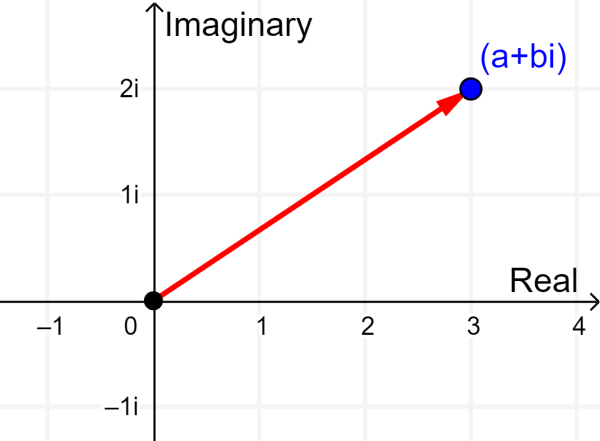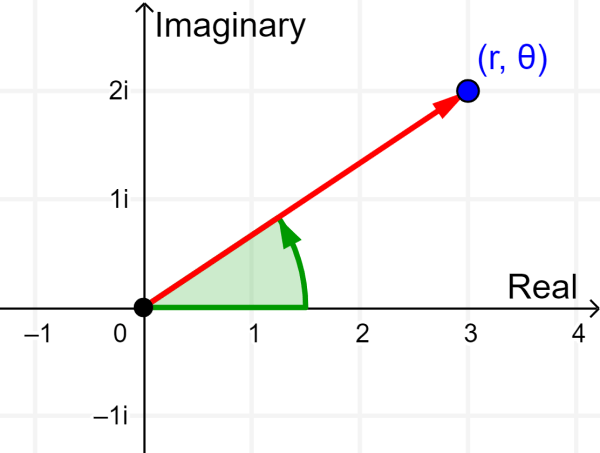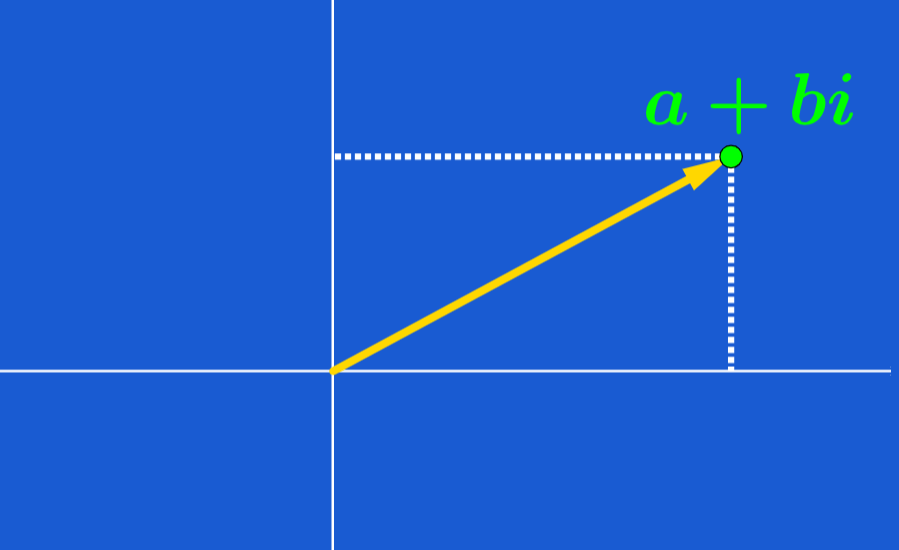By now we are familiar with writing complex numbers in the form z=a+bi. However, there are alternative ways of writing complex numbers that can be convenient when solving mathematical operations with these numbers. Here, we will learn to write complex numbers in polar form.
We will look at the formulas used to transform complex numbers in their polar form and we will look at various solved examples to learn the application of these formulas.
Geometric interpretation of complex numbers
To better understand the alternate versions of complex numbers, we must familiarize ourselves with the geometric interpretation of these numbers as it will lead us directly to their polar form.
Consider the complex number $latex z = a + bi$. We can think of this number as the point (a, b) in the Cartesian coordinate system or as the vector that starts at the origin and ends at the point (a, b). The following graph represents this:

In this interpretation, the x-axis represents real numbers and the y-axis represents imaginary numbers. This plane is often referred to as the complex plane.
Using this plane, we can obtain a geometric interpretation of the modulus or magnitude. We can see that, $latex |z| = \sqrt{{{a}^2} + {{b}^2}}$ is simply the length of the vector used to represent the number $latex z = a + bi$.
Polar form of complex numbers
The polar form is an alternative way of writing complex numbers. If we think of the complex number $latex z = a + bi$ as the point (a, b) in the complex plane, we know that we can represent this point using the polar coordinates $latex (r, \theta)$, where, r is the distance of the point from the origin and θ is the angle, usually in radians, from the positive x-axis to the vector connecting the point to the origin.

When we work with complex numbers, we assume that r is positive and that θ can be any possible angle both positive and negative that ends in the vector. We only consider the polar form of nonzero complex numbers since the angle θ is not defined for the point (0, 0).
We can convert the polar coordinates $latex (r, \theta)$ to the corresponding Cartesian coordinates of the point (a, b) using the following formulas:
$latex a=r~\cos(\theta)$ $latex b=r ~\sin(\theta)$
In the same way, we also have the following formula to obtain r using the Cartesian coordinates a and b:
$latex r=\sqrt{{{a}^2}+{{b}^2}}$
The right side of this formula is the definition of the module or magnitude of the complex number, so we have:
$latex r=|z|$
Using this, we can write complex numbers in their polar form:
| $latex z=r(\cos(\theta)+i~\sin(\theta)$ $latex z=|z|(\cos(\theta)+i~\sin(\theta)$ |
The angle $latex \theta $ is called the argument of z and is denoted by:
$latex \theta=arg(z)$
The argument to z can be any of the infinite possible values of $latex \theta$, which can be found by solving:
$latex \tan(\theta)=\frac{b}{a}$
and we have to make sure that $latex \theta$ is in the correct quadrant.
Suppose we have a complex number z with an argument $latex \theta$. If we increase the value of $latex \theta$, we are rotating the point with respect to the origin in a counterclockwise direction. Since $latex 2 \pi$ represents one complete revolution, we would be back at the starting point when we get to $latex \theta +2 \pi$.
This means that $latex \theta $ and $latex \theta + 2 \pi $ are equivalent. Continuing with this idea, each time we add multiples of $latex 2 \pi $, we obtain an angle equivalent to the original angle.
Operations on complex numbers in polar form
The polar form of complex numbers can make some operations easier.
Equivalent numbers in polar form
For two complex numbers to be equal, their moduli must be the same and their arguments must differ by 2 kπ, where k is any whole number.
For example, if we have $$r(\cos (t)+i\sin (t))=R(\cos (T)+i\sin (T))$$, then, we must have $latex r=R$ and $latex T=t+2k\pi$.
Conjugate of a complex number in polar form
The conjugate number of the complex number $latex a+bi$ is $latex a-bi$. In polar form, the conjugate of the complex number $latex r(\cos (t)+i\sin (t))$ is $latex r(\cos (-t)+i\sin (-t))$.
Product of complex numbers in polar form
To multiply two complex numbers in polar form, we have to multiply their modules and add their arguments. Therefore, we have:
$$r(\cos (t)+i\sin (t))\times R(\cos (T)+i\sin (T))$$
$latex =rR(\cos (t+T)+i\sin (t+T))$
Division of complex numbers in polar form
To divide two complex numbers in polar form, we have to divide their modules and subtract their arguments. Therefore, we have:
$$\frac{r(\cos (t)+i\sin (t))}{R(\cos (T)+i\sin (T))}$$
$latex =\frac{r}{R}(\cos (t-T)+i\sin (t-T))$
Complex numbers in polar form – Examples with answers
The following problems are some examples of operations with complex numbers in polar form.
EXAMPLE 1
If we have the number $latex 6+10i$, what is its equivalent in polar form?
Solution
To transform a complex number written in conventional form to its polar form, we are going to use the formula above. Therefore, we have:
$latex r=\sqrt{{{a}^2}+{{b}^2}}$
$latex =\sqrt{{{6}^2}+{{10}^2}}$
$latex =\sqrt{36+100}$
$latex =\sqrt{136}$
$latex =11.66$
$latex \tan(\theta)=\frac{b}{a}$
$latex \tan(\theta)=\frac{10}{6}$
$latex \theta={{\tan}^{-1}}(\frac{10}{6})$
$latex \theta=1.03$ rad
Therefore, the polar form of the number $latex 6+10i$ is $latex 11.6(\cos(1.03)+i\sin(1.03))$.
EXAMPLE 2
What is the conjugate of the number $latex 5 (\cos (1.8) + i \sin (1.8))$?
Solution
To find the conjugate of a complex number written in polar form, we have to write the modulus as it is and change the argument with a negative sign. Therefore, the conjugate of the given complex number is:
$latex 11.6(\cos(-1.03)+i\sin(-1.03))$
EXAMPLE 3
What is the product of the numbers $latex 5(\cos(0.8)+i\sin(0.8))$ and $latex 8(\cos(1.6)+i\sin(1.6))$?
Solution
To obtain the product of two complex numbers written in polar form, we have to multiply their modules and add their arguments. Therefore, we have:
$$5(\cos(0.8)+i\sin(0.8))\times 8(\cos(1.6)+i\sin(1.6))$$
$latex =40(\cos(2.4)+i\sin(2.4))$
EXAMPLE 4
What is the result of the division? $$\frac{24(\cos(2.7)+i\sin(2.7))}{6(\cos(1.5)+i\sin(1.5))}$$
Solution
To divide two complex numbers written in polar form, we have to divide their modules and subtract their arguments. Therefore, we have:
$$\frac{24(\cos(2.7)+i\sin(2.7))}{6(\cos(1.5)+i\sin(1.5))}$$
$$=\frac{24}{6}(\cos(2.7-1.5)+i\sin(2.7-1.5))$$
$latex =4(\cos(1.2)+i\sin(1.2))$
See also
Interested in learning more about complex numbers? Take a look at these pages:




